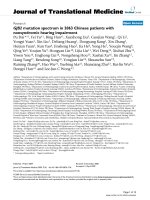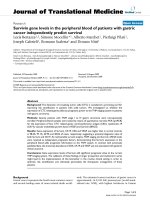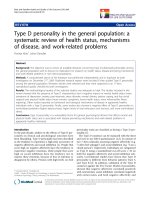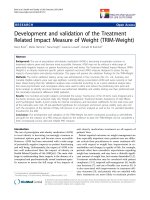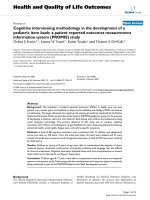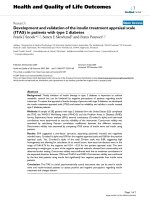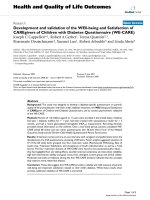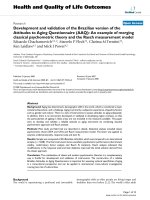Báo cáo hóa học: " Constancy and diversity in the flavivirus fusion peptide Stephen J Seligman" ppt
Bạn đang xem bản rút gọn của tài liệu. Xem và tải ngay bản đầy đủ của tài liệu tại đây (347.57 KB, 10 trang )
BioMed Central
Page 1 of 10
(page number not for citation purposes)
Virology Journal
Open Access
Research
Identification of a contemporary human parechovirus type 1 by
VIDISCA and characterisation of its full genome
Luciano Kleber de Souza Luna
†1
, Sigrid Baumgarte
†2
, Klaus Grywna
1
,
Marcus Panning
1
, Jan Felix Drexler
1
and Christian Drosten*
3
Address:
1
Clinical Virology Group, Bernhard Nocht Institute for Tropical Medicine, Hamburg, Germany,
2
Laboratory of Virology, Department of
Microbiological Consumer Protection, Institute of Hygiene and the Environment, Hamburg, Germany and
3
Institute of Virology, University of
Bonn Medical Centre, Sigmund Freud-Str. 25, 53127 Bonn, Germany
Email: Luciano Kleber de Souza Luna - ; Sigrid Baumgarte - ; Klaus Grywna - grywna@bni-
hamburg.de; Marcus Panning - ; Jan Felix Drexler - ; Christian Drosten* - drosten@bni-
hamburg.de
* Corresponding author †Equal contributors
Abstract
Background: Enteritis is caused by a spectrum of viruses that is most likely not fully characterised.
When testing stool samples by cell culture, virus isolates are sometimes obtained which cannot be
typed by current methods. In this study we used VIDISCA, a virus identification method which has
not yet been widely applied, on such an untyped virus isolate.
Results: We found a human parechovirus (HPeV) type 1 (strain designation: BNI-788st). Because
genomes of contemporary HPeV1 were not available, we determined its complete genome
sequence. We found that the novel strain was likely the result of recombination between structural
protein genes of an ancestor of contemporary HPeV1 strains and nonstructural protein genes from
an unknown ancestor, most closely related to HPeV3. In contrast to the non-structural protein
genes of other HPeV prototype strains, the non-structural protein genes of BNI-788st and HPeV3
prototype strains did not co-segregate in bootscan analysis with that of other prototype strains.
Conclusion: HPeV3 nonstructural protein genes may form a distinct element in a pool of
circulating HPeV non-structural protein genes. More research into the complex HPeV evolution is
required to connect virus ecology with disease patterns in humans.
Background
The Picornaviridae are a highly diversified family of non-
envevloped plus-strand RNA viruses, many of which are
pathogenic for humans. Their full genetic and phenotypic
spectrum is unknown and novel picornavirus strains keep
being discovered [1,2]. Large work has been invested in
recent years in the development of methods for discover-
ing new and unknown viruses. Sophisticated approaches,
such as highly redundant cDNA arrays, high-throughput
cDNA library analysis, and ultradeep sequencing have
been successfully used [3-7]. These methods are expensive
and require expert knowledge, prohibiting their use in
general diagnostic laboratories.
A simpler method, termed Virus Discovery cDNA AFLP
(VIDISCA), uses cell culture supernatants treated by
DNase digestion in a modified cDNA Amplified Fragment
Length Polymorphism (AFLP) analysis. AFLP employs
Published: 12 February 2008
Virology Journal 2008, 5:26 doi:10.1186/1743-422X-5-26
Received: 23 December 2007
Accepted: 12 February 2008
This article is available from: />© 2008 de Souza Luna et al; licensee BioMed Central Ltd.
This is an Open Access article distributed under the terms of the Creative Commons Attribution License ( />),
which permits unrestricted use, distribution, and reproduction in any medium, provided the original work is properly cited.
Virology Journal 2008, 5:26 />Page 2 of 10
(page number not for citation purposes)
restriction enzyme digestion sites in an unknown DNA
sequence to ligate oligonucleotide adaptors, which are
then used as primer binding sites for PCR amplification.
This method has been described originally in the context
of the discovery of a novel human Coronavirus in 2004
[8]. In that study, it was used to amplify an untypable
virus from the supernatant of a cell culture showing a
cytopathic effect (CPE).
As CPE-positive but serologically untypable cell cultures
occur regularly during routine diagnostics, it would be
desirable to have a simple and inexpensive method for the
characterisation of viruses from supernatants. VIDISCA
seems to be an interesting option, even though the proce-
dure has not been employed by other groups after its orig-
inal description [8]. It is unclear whether it can be adapted
for routine use from the literature and whether it is practi-
cally useful.
In this study, we adapted VIDISCA with slight modifica-
tions and applied it on a cytopathic cell-culture obtained
during routine surveillance of human enteritis. From the
culture we amplified fragments of what turned out to be a
human parechovirus type 1. Parechoviruses form a sepa-
rate genus within the family Picornaviridae. Members of
the species Human Parechovirus (HPeV) cause symptoms
of common cold and enteritis, but also encephalitis, myo-
carditis, and other conditions [9]. Until their reclassifica-
tion HPeV types 1 and 2 have been known as Echovirus
types 22 and 23, within the Enterovirus genus. Very
recently, four novel HPeV types have been described, fully
sequenced, and intensively studied [9-16]. Genome data
on HPeV type 1, however, have not been updated after the
genome of the prototype strain was characterised [17].
This strain was isolated in the 1960s. For more recent
strains, only limited sequencing of a small part of the
structural protein gene P1 has been done. Because recent
studies suggested that HPeV 1 may have undergone signif-
icant evolution including recombination with other
strains [14,16], the full genome sequence of the type 1
HPeV identified in this study was determined and ana-
lysed for recombination. We found evidence of the novel
strain resulting from non-recent recombination between
HPeV1 structural protein genes and non-structural pro-
tein genes of another type, potentially type 3. This was
probably followed by another recombination within the
structural protein genes of contemporary type 1 viruses.
Results
During routine diagnostic work on patients with acute
enteritis in a municipal health service, a stool sample from
a 30 year-old female kitchen worker with acute enteritis
displayed a cytopathic effect (CPE) on cultured African
Green Monkey Kidney (GMK) cells. The CPE resembled
that of enteroviruses, including rounding and blebbing,
shrinking, and detachment of cells from the monolayer.
The virus isolate could be passaged to uninfected cells but
showed no detectable neutralisation if subcultured with
several different pools of polyclonal anti-enterovirus sera.
RT-PCR for Norovirus and Enterovirus, PCR for Adenovi-
rus, and antigen-EIA for Astro- and Rotavirus were nega-
tive on the supernatant and on the original patient
material. The unknown isolate was termed BNI-788st. In
order to type it, supernatant was subjected to VIDISCA,
with an additional ultracentrifugation step as opposed to
the original protocol [8]. In the second amplification
stage, one of 16 PCR reactions yielded a distinct amplifi-
cation product (Figure 1). Sequencing showed a 188
nucleotide DNA fragment that was homologous in a
nucleotide BLAST search with the capsid (P1) protein
region of HPeV strains. It should be noted here that no
specific Parechovirus diagnostics (serotyping of cell cul-
ture, RT-PCR) had been done because these viruses are
known to occur almost exclusively in children, and this
patient was an adult.
The VP1 protein gene of BNI-788st was determined as
described in [16]. Phylogenetic analysis showed that it
clustered with that of a group of contemporary HPeV1
strains (Figure 2). As observed earlier [14], the prototype
Echovirus 22 strain Harris had only basal relationship
with these strains. Amino acid identity with prototype
strain Harris was around 92%. Because no full sequence of
Original agarose gel photograph obtained from second ampli-fication step of VIDISCAFigure 1
Original agarose gel photograph obtained from second ampli-
fication step of VIDISCA. Numbering of the 16 second-stage
PCR products is shown above the first and last three lanes.
The product in lane 4 was sequenced and showed a parecho-
virus as described in the text. A 100 bp marker is used on
the gel (500 bp band enhanced, 400, 300, 200, 100 bp).
Virology Journal 2008, 5:26 />Page 3 of 10
(page number not for citation purposes)
any contemporary HPeV1 was available in GenBank, the
complete genome sequence of BNI-788st was analysed.
Genome length was 7337 nucleotides excluding the
poly(A) tract. Genome organization matched that of other
parechoviruses, including a 5' untranslated region (UTR)
of 709 nucleotides, followed by a large open reading
frame of 6537 nucleotides that encoded the putative poly-
protein precursor of 2179 amino acids; and a 3' UTR of 91
nucleotides followed by a poly(A) tail.
Interestingly, the 5' UTR was most similar to that of
HPeV4 viruses, showing 88.9% and 90.8% nucleotide
identity with type 4 prototype strains T75-4077 and
K251176-02, respectively. The predicted RNA secondary
structure elements of the 5' UTR of BNI-788St are depicted
in Figure 3. The shown structures were selected from alter-
native energetically possible structures to resemble most
closely the structures of HPeV1 Harris and HPeV2 Wil-
liamson [18,19]. Differences were observed in stem-loop
elements B, C, G and H. In BNI-788st, corresponding
sequences formed only 2 stem-loops, designated B-C and
G-H. The other stem-loop elements were well conserved,
including I to L which form a type II internal ribosome
entry site (IRES) as described for cardioviruses and aph-
thoviruses [20-22]. A polypyrimidine-rich tract typical of
picornaviruses was present 17 nucleotides upstream of the
initiation codon, including a Kozak sequence
(ANNAUGG).
The predicted secondary structure of the 3' UTR of BNI-
788st is also shown in Figure 3. The conformation in
terms of relative sizes of loop structures was more similar
to HPeV 3 protype strains than to the HPeV 1 prototype
strain ([11]). The region was organised in one continuous
stem-loop element as recently described for HPeV 1–3
[11]. This was in contrast to other enteroviruses whose 3'-
noncoding regions form 2 to 3 such stem loops [23]. A
conserved repeat structure as recently described for proto-
type HPeV [14] was also present.
The genes coding for structural proteins VP0, VP3 and VP1
were most similar to HPeV1, as listed in Table 1. An RGD
motif as present in all HPeV except HPeV 3 was present
[10,12]. This element is critical in attachment and entry
into host cells in other picornaviruses [24] and has been
shown to be essential for infectivity in HPeV [25,26]. All
of the genes coding for the non-structural proteins were
more similar to HPeV3 than to HPeV 1, 2, 4, 5, or 6. Con-
Phylogenetic analysis of P1 protein regions (amino acids 76–773, isolate Harris), analysed using the p-distance substitution modelFigure 2
Phylogenetic analysis of P1 protein regions (amino acids 76–773, isolate Harris), analysed using the p-distance substitution
model. VP1-based HPeV-types are shown next to clades on the right margin. Analysis was conducted in MEGA4 [42]. The evo-
lutionary histories were inferred using the Neighbor-Joining method [44]. Relevant boostrap values from 500 replicate trees
are shown next to the branches [45]. The scale shows evolutionary distance from each root. GenBank accession number of
strain BNI-788st is EF051629
. The tree was rooted against Ljungan virus, a murine parechovirus.
Virology Journal 2008, 5:26 />Page 4 of 10
(page number not for citation purposes)
served elements such as the 2C helicase motifs
GXXGXGK(S/T) and DDLXQ, the 3C protease active-site
motif GXCG, and the 3D RNA-dependent RNA polymer-
ase motifs YGDD, KDELR, PSG, and FLKR were all con-
firmed.
As suggested from above results, as well as from similarity
values listed in Table 1, the protein-coding genes of BNI-
788st might result from recombination between HPeV1
and another HPeV type, potentially type 3. To investigate
this further, similarity plot analysis on the full polyprotein
open reading frame was conducted as shown in Figure 4.
Structural proteins had closest identity with HPeV1 (see
below). The non-structural protein portion was
87–92.8% identical to HPeV3 (Table 1), which is less than
the degree of identity between HPeV3 prototype strains
(96–99%) but more than between prototype strains of
non-homologous types (always below 87%, Table 1 and
data not shown).
Bootscan analysis was done next. Within the structural
gene portion, analysis yielded co-segregation values
between BNI-788st and the prototype HPeV1 strain Harris
in the order of 95% in VP0 and 90% in VP1. For VP3, a
maximum co-segregation value of 70% could be identi-
fied only in a very small part of the protein. An abrupt halt
of co-segregation with the HPeV1 prototype was observed
beyond the VP1 protein portion by bootscan analysis. At
Predicted secondary structure elements of the 5'-noncoding region (A) and 3'-noncoding region (B)Figure 3
Predicted secondary structure elements of the 5'-noncoding region (A) and 3'-noncoding region (B). Capital letters as used in
[19] denominate structural elements of the 5'-noncoding region. Latin numbers for the 3'-nonconding region are used in anal-
ogy with [11].
Virology Journal 2008, 5:26 />Page 5 of 10
(page number not for citation purposes)
the VP1/2A border a crossing point with HPeV4 was iden-
tified by the software, but the region in which co-segrega-
tion occurred was rather short (Figure 4). Over the rest of
the non-structural protein gene, no relevant evidence of
recombination with any other HPeV type was observed.
Thus, only the degree of nucleotide identity (see above)
suggests that the closest relative in the non-structural pro-
tein gene portion may be an HPeV3 strain.
For comparison, bootscan analysis was repeated using
each of the reference strains for HPeV types 1–6 as the
comparison sequence (Figure 5). Most of them showed
significant co-segregation with other reference strains
alternating over parts of their non-structural genes. Such
an observation would be compatible with mosaic recom-
bination in the non-structural genes. No reference strain
showed recombination with BNI-788st. Similarly, no
indication of past recombination with relatives of other
prototypes was seen in the HPeV3 reference strains (see
Figure 5, panels D and E).
To appreciate in more detail the composition of structural
protein genes of BNI-788st, these were compared phylo-
genetically with that of other contemporary viruses co-cir-
culating in Germany as identified in a recent study [16].
As shown in Figure 6, there was a group of related viruses
(BNI-788st, R9, R15, R32) whose VP3 portions were
directly originating from the root point of contemporary
type 1 viruses, suggesting that they stemmed directly from
a common ancestor of all contemporary type 1 viruses.
Other circulating strains from Germany (BNI- R21, R30,
R90) and Japan [10] formed separate evolutionary line-
ages. For VP1 the same group of viruses related to BNI-
788st existed, but one strain (BNI-R30) was placed
between this group and the common ancestor of contem-
porary strains. BNI-R30 may thus have obtained its VP1
protein earlier than the 788st-related viruses from a com-
mon source. Nevertheless, for the 788st-related group
(BNI-788st, R9, R15, R32) the length of the internal
branch leading to its basal node suggests that their VP1
has been obtained from a non-recent ancestor common to
these and most other contemporary HPeV1. In VP0 the
BNI-788st-related group was not so close to the root of
contemporary strains, suggesting that VP0 may have been
acquired by a more recent ancestor of the group by recom-
bination.
Discussion
Enteritis is caused by a spectrum of viruses that is most
likely not fully characterised. When testing stool samples
by cell culture, virus isolates are sometimes obtained
which cannot be typed by current methods. In this study
we confirmed that VIDISCA [8], a virus identification
method which has not yet been widely applied, is capable
of identifying novel viruses grown in cell culture. We
found a contemporary HPeV type 1 strain and analysed its
full genome.
The targeted technical search for novel viral agents has
become a focus in virology, triggered by the identification
of important new agents such as human herpesvirus type
8 [27], human metapneumovirus [28], and SARS-Corona-
virus [29]. More recently identified agents include the
human coronaviruses NL63 [8] and HKU1 [30], human
bocavirus [6], as well as polyomaviruses WU [31] and KI
[4]. Different technical approaches have been followed to
find novel viruses, including whole virus genome micro-
arrays [3], cDNA-libraries [5], as well as ultra deep
sequencing approaches [7]. All of these methods are too
sophisticated and costly for routine application.
Table 1: Nucleotide and amino acid identity with reference strains, by virus protein
Nucleotide Identity (amino acid identity)
Region HPeV1
a
HPeV2
b
HPeV3
c
HPeV3
d
HPeV4
e
HPeV4
f
HPeV5
g
HPeV5
h
HPeV6
i
HPeV6
j
5'UTR86.684.984.985.288.990.8ND*ND88.3ND
VP0 82.6 (94.1) 75.7 (84.1) 70.6 (73.4) 71.0 (73.4) 72.9 (78.9) 72.9 (79.2) 72.3 (79.2) 72.3 (79.2) 72.7 (78.9) 72.3 (79.2)
VP3 76.9 (89.3) 72.8 (82.2) 68.1 (76.3) 67.9 (76.7) 71.7 (79.8) 70.2 (80.2) 68.9 (76.7) 68.5 (77.1) 73.1 (83.4) 72.1 (83.8)
VP1 76.6 (89.6) 71.1 (79.2) 64.2 (70.6) 64.6 (71.0) 70.7 (74.0) 71.7 (77.1) 69.6 (74.0) 65.7 (71.4) 69.7 (74.9) 69.3 (74.9)
2A 76.7 (89.3) 77.1 (87.3) 87.1 (88.0) 88.7 (87.3) 76.2 (89.3) 88.2 (94.7) 79.1 (88.7) 76.2 (88.7) 79.8 (88.7) 78.2 (88.7)
2B 82.2 (96.7) 78.4 (95.9) 91.5 (100.0) 91.0 (100.0) 83.1 (100.0) 85.2 (100.0) 83.9 (98.4) 83.3 (98.4) 82.0 (97.5) 82.8 (98.4)
2C 79.4 (92.7) 77.4 (86.6) 92.8 (99.1) 92.0 (98.8) 82.1 (97.3) 88.1 (98.2) 81.8 (95.1) 79.3 (93.9) 78.6 (91.8) 80.1 (96.4)
3A 75.8 (87.2) 76.9 (83.8) 91.2 (91.5) 92.6 (94.0) 81.8 (93.2) 83.2 (92.3) 80.1 (81.2) 77.5 (88.9) 78.6 (88.0) 80.3 (91.5)
3B 71.7 (90.0) 70.0 (90.0) 86.7 (85.0) 86.7 (90.0) 78.3 (95.0) 73.3 (85.0) 80.0 (90.0) 66.7 (90.0) 78.3 (90.0) 76.7 (90.0)
3C 81.0 (97.0) 81.7 (97.0) 91.0 (98.0) 91.3 (98.5) 86.8 (98.0) 87.0 (97.5) 79.5 (99.0) 80.5 (96.0) 84.2 (98.0) 81.3 (97.0)
3D 82.8 (95.9) 82.9 (94.2) 91.0 (97.0) 90.8 (97.0) 88.7 (97.0) 87.9 (97.7) 82.3 (95.1) 82.4 (93.8) 83.9 (95.7) 82.3 (95.3)
3'UTR 83.3 87.9 94.5 92.3 89.0 94.5 84.6 89.0 83.5 84.6
Strain designations:
a
Harris,
b
Williamson,
c
A308/99,
d
Can82853-01,
e
T75-4077,
f
K251176-02,
g
CT86-6760,
h
T92-15,
i
NII561-2000,
j
BNI-67, *ND = not
determined.
Virology Journal 2008, 5:26 />Page 6 of 10
(page number not for citation purposes)
Using a combination of protected nuclease digestion and
AFLP-PCR, van der Hoek et al. have developed VIDISCA as
an alternative approach to identifying unknown viruses,
at least if they are growing in cell culture [8]. By applying
VIDISCA independently, this study proves that the assay is
applicable and can be reproduced easily from the litera-
ture. The procedure employed a combination of ready-to-
use molecular biology reagents that could be used without
technical difficulties. The entire procedure including virus
particle enrichment, nuclease digestion, nucleic acids
preparation, double stranded cDNA synthesis, restriction
digestion, adapter ligation and two stages of PCR amplifi-
cation took two full working days to be completed.
Hands-on time for one full staff member was about one
working day.
The finding of evidence for a potentially recombinant
ancestry of our contemporary HPeV1 strain is rather inter-
esting. HPeV1 and 2, formerly classified as echovirus types
22 and 23 [32], were described in the 1960s. Recent inten-
sified molecular surveillance has revealed HPeV3 [9-12],
HPeV4 [13], HPeV5 [14], and HPeV6 [15,16] in very short
sequence. However, no further studies of full genomes of
currently circulating isolates of HPeV1 have been con-
ducted. A finding of recombination in principle is not sur-
prising given the propensity of picornaviruses [33-37]
including parechoviruses [14], to recombine. Following
an accepted notion, genomes of the related enteroviruses
form a pool of circulating non-structural gene elements
that maintain themselves in the host population by
recombination with structural protein genes from other
members of their genus [35,36]. Our contemporary strain
was probably derived from a recombinant ancestor, with
a breakpoint at the border between structural and non-
structural genes. Most parts of the structural genes were
similar to HPeV1, while the non-structural genes were
more similar to that of HPeV3. The 5'-noncoding ele-
ments were probably contributed by HPeV4.
The non-structural protein genes of BNI-788st were most
similar to those of HPeV3, and it is interesting that only
BNI-788st and both HPeV3 prototype strains did not
show co-segregation of their non-structural genes with
that of other prototype strains in bootscan analysis.
Within the above-mentioned hypothesis, it would be con-
ceivable that HPeV3 non-structural protein genes could
form more inert elements within the pool of HPeVs that
may not easily recombine with non-structural genes of
other HPeV. Together with our analysis of phylogeny and
recombination patterns, this special feature makes it pos-
sible to reconstruct likely events in the formation of BNI-
788st.
Phylogenetic analysis of the whole non-structural gene
portion placed BNI-788st and both HPeV3 strains behind
a common ancestor with 88% bootstrap support. This
common ancestor would have accepted a complete set of
structural protein genes by recombination in the 5'-proxi-
mal part of the non-structural protein genes, close to the
VP1/2A border. Because the VP3 portion of BNI-788st and
its group of relatives is directly derived from the common
Similarity plot analysisFigure 4
Similarity plot analysis. Analysis was carried out with SimPlot
software [43], using a 200 bp sliding window and 50 bp step
size. Prototype strains used for comparison are shown in the
insert window. A, nucleic acid identity, per analysis window,
for strain BNI-788st with prototype strains. Nucleotide posi-
tions on x-axis show the centre of the window. B, Bootsan
analysis using the same window settings. A bootstrapped
phylogenetic analysis is conducted per window over the
alignment. Graphs represent the percentage (bootstrap val-
ues) at which each strain co-segregates phylogenetically in
the analysis window with strain BNI-788st.
Virology Journal 2008, 5:26 />Page 7 of 10
(page number not for citation purposes)
Bootscan analysis as in Figure 4, employing prototype HPeV strains as query sequencesFigure 5
Bootscan analysis as in Figure 4, employing prototype HPeV strains as query sequences. A, BNI-788st (note a slight difference
in co-segregation graph as opposed to Figure 4, due to a larger sliding window size of 600 bp in this analysis); B, HPeV-1 proto-
type strain Harris; C, HPeV-2 prototype strain Williams; D, HPeV-3 prototype strain A308-99; E, HPeV-3 prototype strain
Can82853-01; F, HPeV-4 prototype strain K251176-02; G, HPeV-4 prototype strain T75-4077; H, HPeV-5 prototype strain
T92-15; I, HPeV-5 prototype strain CT86-6760; J, HPeV-6 prototype strain NII-561-2000; K, HPeV-6 prototype strain BNI-67;
L, color legend. In each panel, each coloured graph represents the degree of phylogenetic co-segregation with the query type
in a 600 bp sliding analysis window, centered around the nucleotide position given on the x-axis. A bootstrapped phylogenetic
analysis was conducted every 50 bp.
Virology Journal 2008, 5:26 />Page 8 of 10
(page number not for citation purposes)
ancestor of VP3 proteins of all contemporary strains, this
recombination would have been a basal, non-recent
event. The same can be confirmed in the VP1 portion,
where the 788st group is in basal position related to the
other contemporary type 1 viruses. It should nevertheless
be mentioned that BNI-R30 seems to have taken its VP1
protein from an even older ancestor that is not preserved
in other contemporary type 1 strains and has also been
lost in BNI-R30 in the other structural protein portions. As
a more recent event in the formation of BNI-788st, the
common ancestor of the BNI-788st-related group would
have acquired its VP0 region from a contemporary type 1
strain. Such intra-capsid recombination in picornaviruses
is an uncommon event [34], but yet it has been described
for several picornaviruses including Foot-and-Mouth Dis-
ease Virus [38], poliomyelitis virus type 1 [39], human
enterovirus species B [40], and hepatitis A virus [41].
As a final step, the 5'-noncoding region of BNI-788st
could have been acquired from an HPeV4, as suggested
from the analysis of its predicted structural properties.
Such recombination is frequently observed in other picor-
naviruses [34]. However, it cannot be analysed from avail-
able data whether this has occurred before or along with
acquisition of VP0. The secondary structure prediction of
the 5'-noncoding region will help following this up, as
soon as more 5'-noncoding region sequences of HPeV 1
and HPeV4 will have been characterised.
Conclusion
In conclusion, this contemporary HPeV1 strain provides
limited but plausible evidence of recombination between
type 3 nonstructural protein genes and type 1 structural
protein genes, which has not been observed before. The
surprising absence of mosaic recombination in the non-
structural protein genes of BNI-788st and of HPeV3 pro-
totype strains underlines the lack of knowledge on the
genesis and ecology of human parechoviruses. More
research into parechovirus genome diversity is necessary
in order to connect virus ecology with disease patterns in
humans.
Materials and Methods
Patients and samples
A cell culture supernatant from GMK-AH1 cells (African
green monkey kidney cells) which showed a cytopatho-
genic effect (CPE) was obtained during routine testing for
agents of viral enteritis.
VIDISCA
Virus discovery cDNA-Amplified Fragment Length Poly-
morphism (AFLP) analysis (VIDISCA) was performed as
described by van der Hoek et al. [8], with minor modifica-
tions. Ten millilitres of culture supernatant were cleared
by centrifugation at 8000 g. Supernatant thereof was cen-
Phylogenetic analysis of the three functional elements of the structural proteins, analysed from amino acid sequences using the p-distance substitution modelFigure 6
Phylogenetic analysis of the three functional elements of the
structural proteins, analysed from amino acid sequences
using the p-distance substitution model. Analysis was con-
ducted in MEGA4 [42]. The evolutionary histories were
inferred using the Neighbor-Joining method [44]. Boostrap
values from 500 replicate trees are shown next to the
branches [45]. The scale shows evolutionary distance from
each root. GenBank accession numbers: [BNI-67, GenBank:
EU022171
; BNI-788st, GenBank: EF051629; BNI-R90, Gen-
Bank: EU024630
; BNIR4, GenBank: EU024631; BNI-R9, Gen-
Bank: EU024632
; BNI-R15, GenBank: EU024633; BNI-R21,
GenBank: EU024634
; BNI-R30, GenBank: EU024635; BNI-
R32, GenBank: EU024636
].
Virology Journal 2008, 5:26 />Page 9 of 10
(page number not for citation purposes)
trifuged at 38.000 g for 4 h. Pellets were treated with 2 U
of DNase 1 (Ambion) in 1X buffer, 100 μl reaction vol-
ume, at 37°C for 1 h. After phenol-/chloroform-based
nucleic acids extraction, cDNA synthesis primed by ran-
dom hexamer oligonucleotides was performed with the
Superscript double stranded cDNA synthesis kit as recom-
mended by the manufacturer (Invitrogen, Karlsruhe, Ger-
many). Enzymatic digestion of cDNA involved HinP1I, as
in the original protocol, and CviAII instead of MseI in
order to optimise the 3'-end of the primer used for ampli-
fication later on. After digestion, 600 nM oligonucleotide
linkers for the HinP1I-site (GACGATGAGTCCTGAT and
Phosphate-CGATCAGGACTCAT, 1:1) and the CviII-site
(CTCGTAGACTGCGTACG and Phosphate-ATCGTACG-
CAGTC, 1:1) were ligated to the complete phenol-purified
digestion product with T4 ligase (Roche, Mannheim, Ger-
many). The first amplification stage (20 cycles, 50 μl reac-
tion volumes) used 300 nM of primers
CTCGTAGACTGCGTACGATG and GACGATGAGTACT-
GATCGC at 56°C annealing temperature with Platinum
Taq polymerase (Invitrogen, Karlsruhe, Germany). Sec-
ond round amplification used four variants of each of the
aforementioned primers, containing single nucleotide
extensions of A, T, G, or C, respectively, at their 3'-ends.
The resulting 16 different combinations of forward and
reverse primers were each used on 2 μl of the first stage
PCR product, under a touchdown cycling protocol: 95°C,
4 min, followed by 10 cycles of 94°C/30s, 65°C, 30s
(temperature decrease of 1°C per cycle), 72°C 1 min, fol-
lowed by 25 cycles of 94°C/30s, 56°C, 30s, 72°C, 1 min.
Enzymes were the same as before. Products were analysed
by agarose gel electrophoresis. Sequencing was done
directly from second stage VIDISCA products on a Beck-
man 2000 XL system using the respective amplification
primers.
Sequencing of full genome
Partial P1 sequences were generated directly from the
VIDISCA product. The full P1 sequence was determined
using upstream primers in the 5'-noncoding region and a
downstream primer in the VIDISCA product. The 2C- to
3D protein gene sequence was obtained by amplifying the
highly conserved distal segment of the 3D gene. Matching
candidate forward primers in the 2C protein were derived
from an alignment of all prototype strains available in
GenBank in November 2005. Long-range PCR was done
with the Expand High Fidelity kit (Roche, Penzberg, Ger-
many). Obtained products from successful long-range
amplifications were cloned in pCR4 vectors (Invitrogen)
and sequenced by primer walking technique. Primers in
the P1 and the 2C/3D fragment were designed specifically
for determined sequences and used to amplify a P1-2C
fragment, which was also cloned and sequenced by
primer walking. Sequences were confirmed from virus
RNA by direct sequencing after sequencing of clones. All
primer sequences are available upon request. GenBank
accession number of strain BNI-788st is EF051629
.
Phylogenetic and recombination analysis
Phylogenetic analyses were conducted in MEGA4 [42].
RNA secondary structure was predicted by Mfold, version
3.2 (Zucker, 2003. Similarity plots and Bootscan analyses
were done with Simplot software [43]).
Abbreviations
AFLP: Amplified fragment length polymorphism analysis;
VIDISCA: Virus Discovery cDNA AFLP; HPeV: Human
parechovirus.
Competing interests
The author(s) declare that they have no competing inter-
ests.
Authors' contributions
LKSL conducted VIDISCA experiments and full genome
sequencing.
SB did cell culture screening of stool samples and identi-
fied initially the described virus strain.
KG, MP, and JFD conducted full genome sequencing and
assisted with in-silico analyses.
CD organised the work, conducted in-silico analyses, and
wrote the manuscript. All authors have read and approved
the final manuscript.
Acknowledgements
This study was supported by the German Ministry of Health (BMGS) as a
part of funding of the National Reference Centre for Tropical Infections at
the Bernhard Nocht-Institute.
L.K.S.L. is a fellow of the Conselho Nacional de Desenvolvimento Científico
e Tecnológico (CNPq), Brazil. We are grateful to H. Hilbig-Hanl, H.
Kocken, U. Krause, G. Mueseler, E. Voß, and B. Liedigk for excellent tech-
nical assistance.
References
1. Kapoor A, Victoria J, Simmonds P, Wang C, Shafer RW, Nims R,
Nielsen O, Delwart E: A highly divergent picornavirus in a
marine mammal. J Virol 2008, 82:311-320.
2. Kistler A, Avila PC, Rouskin S, Wang D, Ward T, Yagi S, Schnurr D,
Ganem D, DeRisi JL, Boushey HA: Pan-viral screening of respira-
tory tract infections in adults with and without asthma
reveals unexpected human coronavirus and human rhinovi-
rus diversity. J Infect Dis 2007, 196:817-825.
3. Wang D, Coscoy L, Zylberberg M, Avila PC, Boushey HA, Ganem D,
DeRisi JL: Microarray-based detection and genotyping of viral
pathogens. Proc Natl Acad Sci U S A 2002, 99:15687-15692.
4. Allander T, Andreasson K, Gupta S, Bjerkner A, Bogdanovic G, Pers-
son MA, Dalianis T, Ramqvist T, Andersson B: Identification of a
third human polyomavirus. J Virol 2007, 81:4130-4136.
5. Allander T, Emerson SU, Engle RE, Purcell RH, Bukh J: A virus dis-
covery method incorporating DNase treatment and its
application to the identification of two bovine parvovirus
species. Proc Natl Acad Sci U S A 2001, 98:11609-11614.
Virology Journal 2008, 5:26 />Page 10 of 10
(page number not for citation purposes)
6. Allander T, Tammi MT, Eriksson M, Bjerkner A, Tiveljung-Lindell A,
Andersson B: Cloning of a human parvovirus by molecular
screening of respiratory tract samples. Proc Natl Acad Sci U S A
2005, 102:12891-12896.
7. Margulies M, Egholm M, Altman WE, Attiya S, Bader JS, Bemben LA,
Berka J, Braverman MS, Chen YJ, Chen Z, Dewell SB, Du L, Fierro JM,
Gomes XV, Godwin BC, He W, Helgesen S, Ho CH, Irzyk GP, Jando
SC, Alenquer ML, Jarvie TP, Jirage KB, Kim JB, Knight JR, Lanza JR,
Leamon JH, Lefkowitz SM, Lei M, Li J, Lohman KL, Lu H, Makhijani VB,
McDade KE, McKenna MP, Myers EW, Nickerson E, Nobile JR, Plant
R, Puc BP, Ronan MT, Roth GT, Sarkis GJ, Simons JF, Simpson JW,
Srinivasan M, Tartaro KR, Tomasz A, Vogt KA, Volkmer GA, Wang
SH, Wang Y, Weiner MP, Yu P, Begley RF, Rothberg JM: Genome
sequencing in microfabricated high-density picolitre reac-
tors. Nature 2005, 437:376-380.
8. van der Hoek L, Pyrc K, Jebbink MF, Vermeulen-Oost W, Berkhout
RJ, Wolthers KC, Wertheim-van Dillen PM, Kaandorp J, Spaargaren J,
Berkhout B: Identification of a new human coronavirus. Nat
Med 2004, 10:368-373.
9. Benschop KS, Schinkel J, Minnaar RP, Pajkrt D, Spanjerberg L, Kraak-
man HC, Berkhout B, Zaaijer HL, Beld MG, Wolthers KC: Human
parechovirus infections in Dutch children and the association
between serotype and disease severity. Clin Infect Dis 2006,
42:204-210.
10. Ito M, Yamashita T, Tsuzuki H, Takeda N, Sakae K: Isolation and
identification of a novel human parechovirus. J Gen Virol 2004,
85:391-398.
11. Abed Y, Boivin G: Molecular characterization of a Canadian
human parechovirus (HPeV)-3 isolate and its relationship to
other HPeVs. J Med Virol 2005, 77:566-570.
12. Boivin G, Abed Y, Boucher FD: Human parechovirus 3 and neo-
natal infections. Emerg Infect Dis 2005, 11:103-105.
13. Benschop KS, Schinkel J, Luken ME, van den Broek PJ, Beersma MF,
Menelik N, van Eijk HW, Zaaijer HL, VandenBroucke-Grauls CM,
Beld MG, Wolthers KC: Fourth human parechovirus serotype.
Emerg Infect Dis 2006, 12:1572-1575.
14. Al-Sunaidi M, Williams CH, Hughes PJ, Schnurr DP, Stanway G: Anal-
ysis of a new human parechovirus allows the definition of
parechovirus types and the identification of RNA structural
domains.
J Virol 2007, 81:1013-1021.
15. Watanabe K, Oie M, Higuchi M, Nishikawa M, Fujii M: Isolation and
characterization of novel human parechovirus from clinical
samples. Emerg Infect Dis 2007, 13:889-895.
16. Baumgarte S, Luna LKS, Grywna K, Panning M, Drexler JF, Karsten C,
Huppertz HI, Drosten C: Prevalence, types, and RNA concen-
trations of human parechoviruses in patients with acute
enteritis, including a sixth parechovirus type. Journal of Clinical
Microbiology 2008, 46:242-248.
17. Hyypia T, Horsnell C, Maaronen M, Khan M, Kalkkinen N, Auvinen P,
Kinnunen L, Stanway G: A distinct picornavirus group identified
by sequence analysis. Proc Natl Acad Sci U S A 1992, 89:8847-8851.
18. Oberste MS, Maher K, Pallansch MA: Complete sequence of
echovirus 23 and its relationship to echovirus 22 and other
human enteroviruses. Virus Res 1998, 56:217-223.
19. Ghazi F, Hughes PJ, Hyypia T, Stanway G: Molecular analysis of
human parechovirus type 2 (formerly echovirus 23). J Gen
Virol 1998, 79 ( Pt 11):2641-2650.
20. Duke GM, Hoffman MA, Palmenberg AC: Sequence and structural
elements that contribute to efficient encephalomyocarditis
virus RNA translation. J Virol 1992, 66:1602-1609.
21. Jang SK, Pestova TV, Hellen CU, Witherell GW, Wimmer E: Cap-
independent translation of picornavirus RNAs: structure and
function of the internal ribosomal entry site. Enzyme 1990,
44:292-309.
22. Pilipenko EV, Blinov VM, Agol VI: Gross rearrangements within
the 5'-untranslated region of the picornaviral genomes.
Nucleic Acids Res 1990, 18:3371-3375.
23. Mirmomeni MH, Hughes PJ, Stanway G: An RNA tertiary struc-
ture in the 3' untranslated region of enteroviruses is neces-
sary for efficient replication. J Virol 1997, 71:2363-2370.
24. Roivainen M, Hyypia T, Piirainen L, Kalkkinen N, Stanway G, Hovi T:
RGD-dependent entry of coxsackievirus A9 into host cells
and its bypass after cleavage of VP1 protein by intestinal pro-
teases. J Virol 1991, 65:4735-4740.
25. Stanway G, Kalkkinen N, Roivainen M, Ghazi F, Khan M, Smyth M,
Meurman O, Hyypia T: Molecular and biological characteristics
of echovirus 22, a representative of a new picornavirus
group. J Virol 1994, 68:8232-8238.
26. Boonyakiat Y, Hughes PJ, Ghazi F, Stanway G: Arginine-glycine-
aspartic acid motif is critical for human parechovirus 1 entry.
J Virol 2001, 75:10000-10004.
27. Schalling M, Ekman M, Kaaya EE, Linde A, Biberfeld P: A role for a
new herpes virus (KSHV) in different forms of Kaposi's sar-
coma. Nat Med 1995, 1:707-708.
28. van den Hoogen BG, de Jong JC, Groen J, Kuiken T, de Groot R,
Fouchier RA, Osterhaus AD: A newly discovered human pneu-
movirus isolated from young children with respiratory tract
disease. Nat Med 2001, 7:719-724.
29. Drosten C, Gunther S, Preiser W, van der Werf S, Brodt HR, Becker
S, Rabenau H, Panning M, Kolesnikova L, Fouchier RA, Berger A, Bur-
guiere AM, Cinatl J, Eickmann M, Escriou N, Grywna K, Kramme S,
Manuguerra JC, Muller S, Rickerts V, Sturmer M, Vieth S, Klenk HD,
Osterhaus AD, Schmitz H, Doerr HW: Identification of a novel
coronavirus in patients with severe acute respiratory syn-
drome. N Engl J Med 2003, 348:1967-1976.
30. Woo PC, Lau SK, Chu CM, Chan KH, Tsoi HW, Huang Y, Wong BH,
Poon RW, Cai JJ, Luk WK, Poon LL, Wong SS, Guan Y, Peiris JS, Yuen
KY: Characterization and complete genome sequence of a
novel coronavirus, coronavirus HKU1, from patients with
pneumonia. J Virol 2005, 79:884-895.
31. Gaynor AM, Nissen MD, Whiley DM, Mackay IM, Lambert SB, Wu G,
Brennan DC, Storch GA, Sloots TP, Wang D: Identification of a
novel polyomavirus from patients with acute respiratory
tract infections. PLoS Pathog 2007, 3:e64.
32. Wigand R, Sabin AB: Properties of ECHO types 22, 23 and 24
viruses. Arch Gesamte Virusforsch 1961, 11:224-247.
33. Simmonds P, Welch J: Frequency and dynamics of recombina-
tion within different species of human enteroviruses. J Virol
2006, 80:483-493.
34. Simmonds P: Recombination and selection in the evolution of
picornaviruses and other Mammalian positive-stranded
RNA viruses. J Virol 2006, 80:11124-11140.
35. Lukashev AN, Lashkevich VA, Ivanova OE, Koroleva GA, Hinkkanen
AE, Ilonen J: Recombination in circulating Human enterovirus
B: independent evolution of structural and non-structural
genome regions. J Gen Virol 2005, 86:3281-3290.
36. Oberste MS, Maher K, Pallansch MA: Evidence for frequent
recombination within species human enterovirus B based on
complete genomic sequences of all thirty-seven serotypes. J
Virol 2004, 78:855-867.
37. Santti J, Hyypia T, Kinnunen L, Salminen M: Evidence of recombi-
nation among enteroviruses. J Virol 1999, 73:8741-8749.
38. Tosh C, Hemadri D, Sanyal A: Evidence of recombination in the
capsid-coding region of type A foot-and-mouth disease virus.
J Gen Virol 2002, 83:2455-2460.
39. Yang CF, Chen HY, Jorba J, Sun HC, Yang SJ, Lee HC, Huang YC, Lin
TY, Chen PJ, Shimizu H, Nishimura Y, Utama A, Pallansch M, Miya-
mura T, Kew O, Yang JY: Intratypic recombination among line-
ages of type 1 vaccine-derived poliovirus emerging during
chronic infection of an immunodeficient patient. J Virol 2005,
79:12623-12634.
40. Oberste MS, Penaranda S, Pallansch MA: RNA recombination
plays a major role in genomic change during circulation of
coxsackie B viruses. J Virol 2004, 78:2948-2955.
41. Costa-Mattioli M, Ferre V, Casane D, Perez-Bercoff R, Coste-Burel
M, Imbert-Marcille BM, Andre EC, Bressollette-Bodin C, Billaudel S,
Cristina J: Evidence of recombination in natural populations of
hepatitis A virus. Virology 2003, 311:51-59.
42. Tamura K, Dudley J, Nei M, Kumar S: MEGA4: Molecular Evolu-
tionary Genetics Analysis (MEGA) Software Version 4.0. Mol
Biol Evol 2007.
43. Lole KS, Bollinger RC, Paranjape RS, Gadkari D, Kulkarni SS, Novak
NG, Ingersoll R, Sheppard HW, Ray SC: Full-length human immu-
nodeficiency virus type 1 genomes from subtype C-infected
seroconverters in India, with evidence of intersubtype
recombination. J Virol
1999, 73:152-160.
44. Saitou N, Nei M: The neighbor-joining method: a new method
for reconstructing phylogenetic trees. Mol Biol Evol 1987,
4:406-425.
45. Felsenstein J: Phylogenies from molecular sequences: infer-
ence and reliability. Annu Rev Genet 1988, 22:521-565.
